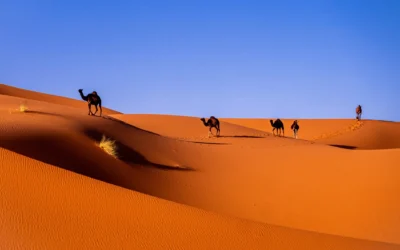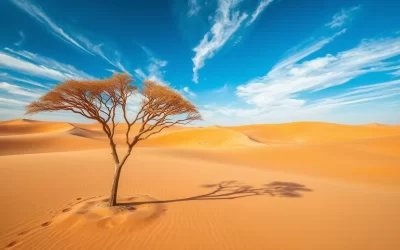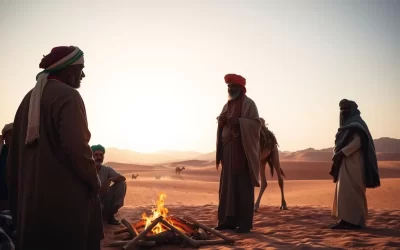Did you know that this territory spans over 266,000 square kilometers, blending endless deserts with stunning Atlantic coastlines? This unique region offers a mix of natural beauty and rich history that captivates every visitor.
The area is a fascinating blend of cultural influences, shaped by its disputed status. While Morocco administers most of the region, the Sahrawi Arab Democratic Republic controls a smaller portion. This duality adds to its intriguing character.
When you visit, you’ll find the Moroccan dirham as the primary currency, reflecting the region’s ties to Morocco. Whether you’re exploring the vast dunes or relaxing by the coast, this destination promises an unforgettable experience.
Overview of Western Sahara: A Traveler’s Introduction
Stretching across a massive area, this territory offers a blend of natural wonders. From dramatic border regions to endless horizons, it’s a place that captures the imagination. Whether you’re drawn to the sandy desert or the sparkling Atlantic coast, this destination promises unforgettable experiences.
The desert environment here is both challenging and alluring. Its vast, open spaces invite exploration, while the coastal views provide a refreshing contrast. This unique combination makes it a must-see for adventurous travelers.
When planning your visit, keep in mind the region’s diverse landscapes. The sandy dunes stretch for miles, offering a sense of isolation and wonder. Meanwhile, the coastal areas are perfect for relaxation and enjoying the Atlantic breeze.
Here are some key highlights to consider:
- Border regions: Explore the dramatic edges where the desert meets the coast.
- Desert adventures: Experience the thrill of navigating the sandy terrain.
- Coastal beauty: Relax by the Atlantic and enjoy the scenic views.
To help you plan, here’s a quick overview of what to expect:
| Feature | Description |
|---|---|
| Desert | Vast, sandy landscapes perfect for exploration. |
| Coast | Sparkling Atlantic views ideal for relaxation. |
| Border | Dramatic regions where landscapes meet. |
This area’s raw beauty and unique charm make it a standout destination. Whether you’re an adventurer or a nature lover, there’s something here for everyone.
Discovering the History and Political Landscape
From colonial rule to modern disputes, this area’s history is both complex and captivating. Its story is shaped by centuries of influence, leaving a legacy that continues to impact the lives of local people today. Understanding this past is essential to appreciating the region’s present and future.
Colonial Legacy and the Path to Dispute
The colonial era left a lasting mark on this territory. European powers once vied for control, leaving behind a fragmented political landscape. Over time, this led to tensions and disputes that persist today. The struggle for sovereignty has shaped the lives of the local population, creating a unique cultural identity.
Roads and borders play a significant role in this history. They not only connect communities but also mark the lines of control. These pathways are more than just routes; they are symbols of division and unity.
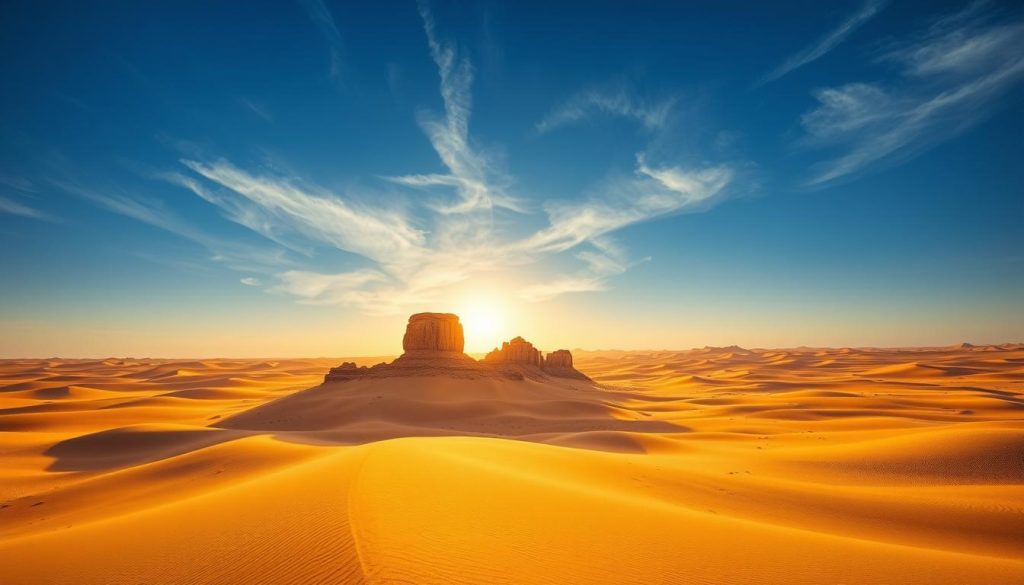
The Berm: Navigating a Divided Territory
One of the most striking features of this region is the berm, a massive sand wall that divides the territory. Stretching for miles, it separates areas under different administrations. This structure is a physical reminder of the ongoing disputes.
The sand-covered landscapes around the berm are both beautiful and haunting. They reflect the challenges faced by those who live here. Despite these divisions, the coast remains a unifying element, offering a shared space for connection and reflection.
Here’s a quick overview of key historical and political elements:
| Feature | Description |
|---|---|
| Colonial Legacy | European influence shaped the region’s political landscape. |
| The Berm | A sand wall dividing the territory, symbolizing ongoing disputes. |
| Roads and Borders | Key markers of control and connection in the region. |
| Coastal Influence | A unifying element in a divided land. |
Exploring this history offers a deeper understanding of the region’s complexities. It’s a journey through time, revealing the resilience and strength of its people.
Navigating Entry, Visas, and Transportation
Planning your trip to this unique region starts with understanding entry and transportation options. Whether you arrive by air or overland, knowing the logistics ensures a smooth journey. This guide covers everything from visas to border formalities, helping you confidently explore this fascinating destination.
Air Arrivals and Overland Journeys
Most international flights land in nearby cities like Casablanca or Marrakech. From there, you can take domestic flights or overland routes to reach the region. Overland travel offers a chance to experience the diverse landscapes, but it requires careful planning. Roads are generally in good condition, but narrow and congested in some areas.
If you’re traveling from neighboring countries like Mauritania or Algeria, border crossings are possible but come with specific requirements. Always check the latest updates, as border policies can change. “Preparation is key to a hassle-free journey,” says a seasoned traveler.
Visa and Border Requirement Essentials
For most visitors, no separate visa is required for this region. Passport validity must extend at least six months beyond your departure date. Border checks are straightforward, with no special stamps for the area. However, if you’re entering from a neighboring democratic republic, additional documentation may be needed.
Here’s a quick checklist for your trip:
- Ensure your passport has at least six months of validity.
- Check visa requirements based on your entry point (Morocco or Mauritania).
- Carry proof of accommodation and return tickets.
- Familiarize yourself with local currency, the dirham, and exchange rates.
By following these tips, you’ll navigate entry and transportation with ease, leaving more time to enjoy your adventure.
Geographic Wonders and Must-Visit Destinations
From towering dunes to serene beaches, this area offers a diverse range of natural wonders. The interplay of desert and ocean creates a landscape that’s both dramatic and tranquil. Whether you’re drawn to the vast sands or the sparkling coastline, this land promises unforgettable experiences.
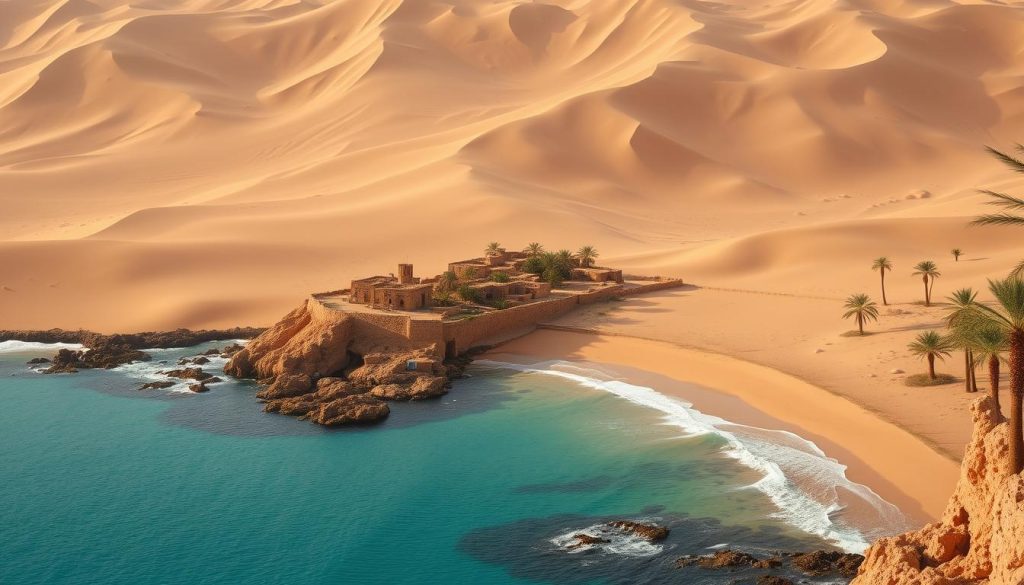
Desert Landscapes and Coastal Beauty
The White Dune is a must-see for any visitor. Its pristine sands stretch endlessly, offering a sense of isolation and wonder. Nearby, isolated beaches provide a peaceful retreat, where the Atlantic waves meet the shore in perfect harmony.
This unique place is a haven for photographers and nature lovers. The contrast between the golden dunes and the blue ocean creates breathtaking views. Don’t miss the chance to capture these moments.
Urban Gems: Laayoune and Dakhla Highlights
Under the Moroccan government, urban centers like Laayoune and Dakhla blend modernity with tradition. Laayoune, the largest city, offers vibrant markets and cultural landmarks. Dakhla, known for its lagoon, is a hotspot for water sports and relaxation.
These cities provide modern amenities while preserving their unique charm. Whether you’re exploring local cuisine or enjoying the lively atmosphere, you’ll find plenty to love.
Here’s a quick guide to the region’s top attractions:
| Destination | Highlights |
|---|---|
| White Dune | Pristine sands, perfect for photography. |
| Isolated Beaches | Serene spots for relaxation and reflection. |
| Laayoune | Vibrant markets and cultural landmarks. |
| Dakhla | Lagoon views and water sports activities. |
This land, with its mix of sand and sea, is a paradise for explorers and culture enthusiasts alike. Whether you’re hiking the dunes or strolling the beaches, every moment here is a discovery.
Western Sahara: Ultimate Travelers Guide to Currencies & Payments
Understanding the local currency is essential for a smooth travel experience in this region. The Moroccan dirham (MAD) is the official currency in the Moroccan-controlled areas, making it the primary form of payment. Whether you’re shopping at local markets or dining at restaurants, knowing how to handle money will make your trip more enjoyable.
Understanding the Moroccan Dirham
The Moroccan dirham is divided into 100 santimat, and it’s widely accepted in most parts of the region. In areas under Moroccan control, you’ll find it’s the only currency used for everyday transactions. Cash is especially important in smaller towns and remote areas, where card payments may not be an option.
Here’s a quick guide to the dirham’s value compared to other currencies:
- 1 US Dollar (USD) = 10.1 MAD
- 1 Euro (EUR) = 10.52 MAD
- 1 British Pound (GBP) = 12.68 MAD
Exchange Rates and Card Use Tips
Exchange rates can vary, so it’s a good idea to check them before your trip. While credit cards are accepted in larger establishments like hotels and restaurants, cash is king in local markets and smaller shops. “Always carry small denominations,” advises a frequent traveler. This ensures you can pay easily, especially in night markets where vendors may not have change for larger bills.
Here are some practical tips for managing your money:
- Use ATMs in cities for cash withdrawals, but be aware of potential fees.
- Carry a mix of cards and cash for flexibility.
- Keep small bills handy for tipping and small purchases.
By following these tips, you’ll navigate the local currency system with confidence, ensuring a hassle-free experience in this fascinating part of the world.
Budget Travel Insights: Costs, Amenities, and Money-Saving Strategies
Exploring this region doesn’t have to break the bank. With careful planning, you can enjoy its beauty and culture without overspending. This guide shares practical tips to help you save money while making the most of your journey.
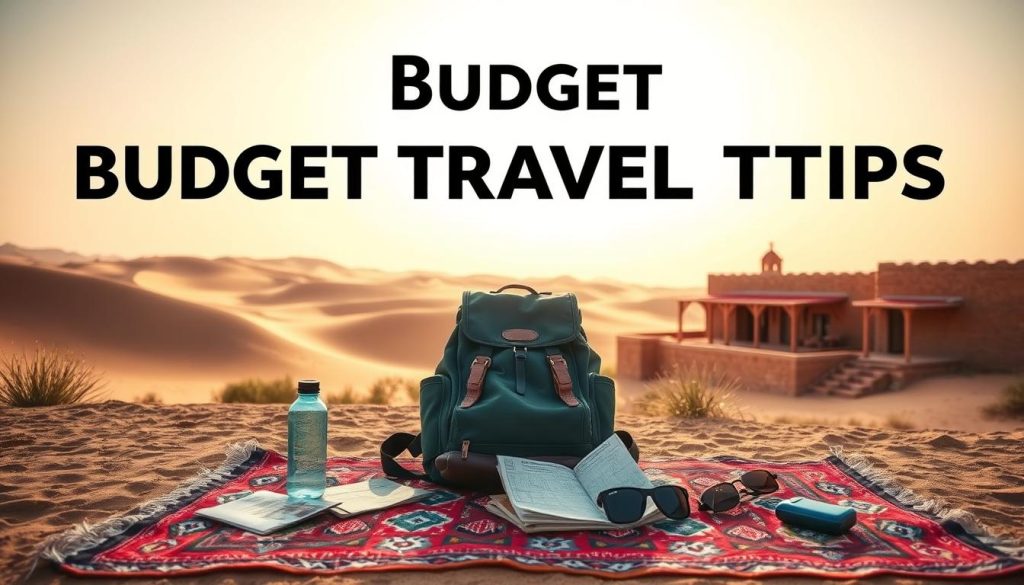
Affordable Experiences and Dining Options
Accommodations here range from budget-friendly guesthouses to mid-range hotels. Staying in smaller towns can save you money compared to larger cities. Look for places that include breakfast to cut down on dining costs.
Local markets are a great way to experience the culture while staying on budget. Fresh produce and street food are both delicious and affordable. “Eating like a local is not only cheaper but also more authentic,” says a frequent traveler.
Here are some tips for managing your daily expenses:
- Transportation: Use shared taxis or public buses to save on travel costs.
- Food: Opt for local eateries instead of touristy restaurants.
- Activities: Many natural attractions are free or have minimal entry fees.
Government subsidies help keep prices low in certain areas. For example, public transportation and basic goods are often more affordable due to these programs. This makes it easier to stretch your budget further.
When planning your trip, remember to carry small denominations of the local currency. This ensures you can pay easily, especially in markets where vendors may not have change for larger bills. Always keep your passport handy for identification and safety.
By following these strategies, you can explore this fascinating region without worrying about your wallet. Whether you’re here for a week or a month, these tips will help you make the most of your adventure.
Cultural Immersion: People, Cuisine, and Local Traditions
Step into a world where time-honored traditions shape daily life. The vibrant culture of this region is deeply rooted in its history and community practices. From elaborate tea ceremonies to warm hospitality, every experience offers a glimpse into the local way of life.
One of the most cherished traditions is the tea ceremony. This ritual, passed down through generations, symbolizes hospitality and connection. “Sharing tea is more than a drink; it’s a moment of togetherness,” says a local resident. The process involves brewing mint tea in a specific way, often accompanied by lively conversations.
Communal experiences like these reflect the strong social fabric of the region. Historic events have shaped modern traditions, blending North African customs with local practices. For example, the communal bakery, or furan, has been in operation for centuries, bringing people together over freshly baked bread.
Here are some ways to immerse yourself in the culture:
- Tea Ceremonies: Participate in this cherished ritual to connect with locals.
- Markets: Explore vibrant souks to experience daily life and local cuisine.
- Historic Sites: Visit landmarks that tell the story of the region’s past.
By engaging with these traditions, you’ll gain a deeper appreciation for the warmth and diversity of the people. Whether you’re sipping tea or exploring a bustling market, every moment here is a cultural adventure.
Adventure and Outdoor Activities in the Sahara
The vast, untamed landscapes of this region are a playground for adventure seekers. Whether you’re racing across desert dunes or riding the waves along the coast, there’s no shortage of excitement here. This area offers a mix of heart-pumping activities and serene escapes, making it a must-visit for nature lovers and thrill-seekers alike.
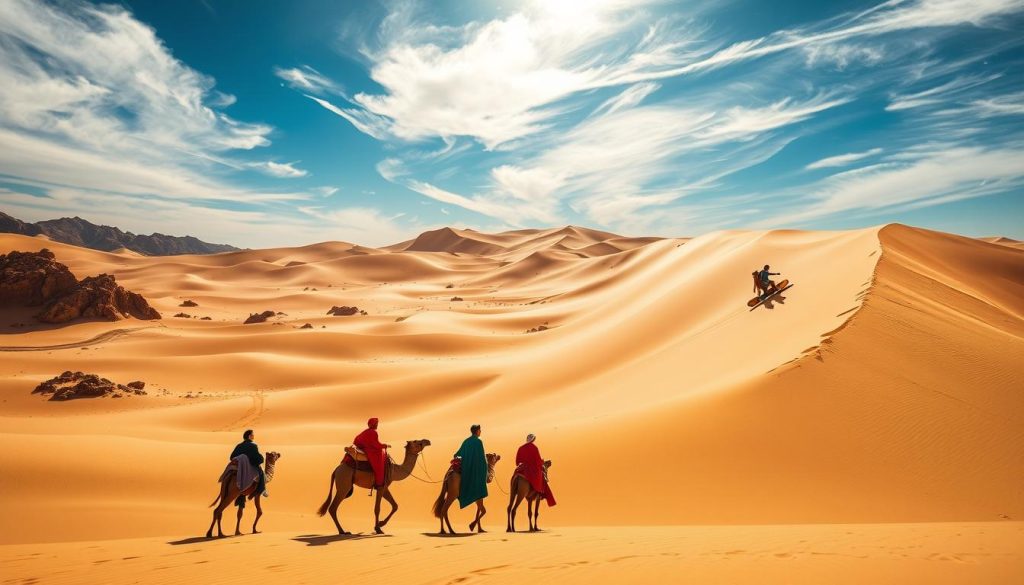
Thrilling Desert Tours and 4WD Expeditions
Explore the rugged beauty of the desert with a 4WD expedition. These tours take you deep into the golden sands, offering breathtaking views and unforgettable experiences. A sturdy vehicle is a must for navigating the challenging terrain, so ensure your tour operator meets all safety requirements.
Organized tours often include stops at hidden oases and historic landmarks. “The desert is vast, but every corner has a story to tell,” says a local guide. Whether you’re a seasoned adventurer or a first-time explorer, these expeditions promise an adrenaline rush like no other.
Kite-Surfing, Beaches, and Nature Escapes
For water sports enthusiasts, the Atlantic Ocean near Dakhla is a kite-surfing paradise. The windy lagoons and pristine beaches provide the perfect conditions for this thrilling activity. Beginners can take lessons, while experienced surfers can challenge themselves with the strong coastal winds.
If you prefer a more relaxed pace, the beaches along the Atlantic Ocean are ideal for unwinding. The combination of golden sands and sparkling waters creates a serene atmosphere. Don’t forget to pack sunscreen and a camera to capture the stunning views.
Here’s a quick guide to planning your adventure:
| Activity | Highlights |
|---|---|
| 4WD Desert Tours | Explore hidden oases and historic landmarks. |
| Kite-Surfing | Ride the winds along the Atlantic coast. |
| Beach Escapes | Relax on pristine beaches with stunning ocean views. |
With its mix of desert and coastal adventures, this region offers something for everyone. Whether you’re speeding across the dunes or gliding over the waves, every moment here is a chance to connect with nature’s wonders.
Travel Logistics: Accommodations and Getting Around
Exploring this region’s urban hubs and transportation options can make your trip seamless. Whether you’re staying in bustling cities or smaller towns, understanding where to stay and how to move around ensures a stress-free experience. This guide covers everything from budget-friendly stays to local transit tips.
Best Stays in Laayoune and Dakhla
Laayoune, the largest city, offers a mix of modern hotels and cozy guesthouses. For budget travelers, local guesthouses provide affordable rates and a chance to connect with the community. Mid-range options include hotels with amenities like Wi-Fi and breakfast, perfect for those seeking comfort without breaking the bank.
Dakhla, known for its lagoon views, is a hotspot for water sports enthusiasts. Here, you’ll find beachfront stays and eco-lodges that blend comfort with nature. “Booking early ensures you get the best deals,” advises a frequent visitor. Whether you prefer a city vibe or a coastal retreat, both towns cater to diverse preferences.
Local Transportation Tips
Getting around in these cities is straightforward, thanks to shared taxis and public buses. Shared taxis, known as Grand Taxis, operate on fixed routes and are a cost-effective way to travel. Public buses connect major areas, making it easy to explore without a car.
In smaller towns, walking is often the best way to soak in the local atmosphere. For longer distances, consider renting a car for flexibility. “Always confirm fares before starting your journey,” suggests a local guide. This helps avoid misunderstandings and ensures a smooth ride.
Here’s a quick overview of accommodation options in Laayoune and Dakhla:
| City | Accommodation Type | Highlights |
|---|---|---|
| Laayoune | Guesthouses | Affordable, community-focused stays. |
| Laayoune | Mid-Range Hotels | Modern amenities, central locations. |
| Dakhla | Beachfront Lodges | Scenic views, eco-friendly options. |
| Dakhla | Eco-Lodges | Nature-focused, sustainable stays. |
By understanding the layout of these cities and their transportation systems, you’ll navigate your journey with ease. Whether you’re exploring urban centers or relaxing by the coast, these tips ensure a hassle-free experience.
Safety and Practical Tips for the Informed Traveler
Ensuring your safety is a top priority when exploring this unique region. From desert adventures to urban explorations, being well-prepared helps you enjoy your trip without worries. Here’s a guide to staying safe and informed during your journey.
Desert Safety and Landmine Awareness
When venturing into the desert, always stick to marked paths and avoid unmarked areas. Landmines near the berm remain a concern, so follow local advice and stay within safe zones. “A little caution goes a long way in ensuring a safe adventure,” says a seasoned traveler.
If you’re planning a 4WD tour, ensure your vehicle is in excellent condition. Carry extra water, a first-aid kit, and a reliable map. These essentials can make all the difference in case of an emergency.
Health and Communication Essentials
Staying healthy is crucial, especially in remote areas. Drink bottled water and avoid raw or undercooked fish to prevent foodborne illnesses. Pack a basic medical kit with essentials like pain relievers and bandages.
Communication can be challenging in remote regions. Learn a few basic phrases in French or Arabic, as these languages are widely spoken. Keep a local SIM card or an international roaming plan for emergencies.
By staying informed and prepared, you can focus on enjoying your adventure. Whether you’re exploring the desert or navigating urban hubs, these tips ensure a smooth and secure experience in this fascinating country.
Conclusion
This region offers a unique blend of natural beauty and cultural richness. From the vast desert landscapes to the sparkling water of the Atlantic coast, every view tells a story. The allure of this territory lies in its diverse geography and intriguing political landscape, shaped by its land border and the influence of the polisario front.
As you plan your journey, remember the practical tips shared in this guide. Whether navigating the local currency, exploring the capital, or ensuring safety in remote areas, preparation is key. These insights will help you make the most of your adventure.
Embrace the warmth of the people, the depth of the culture, and the beauty of the land. With confidence and curiosity, you’re ready to explore this captivating region. Your adventure awaits!
The above is subject to change.
Check back often to TRAVEL.COM for the latest travel tips and deals.

